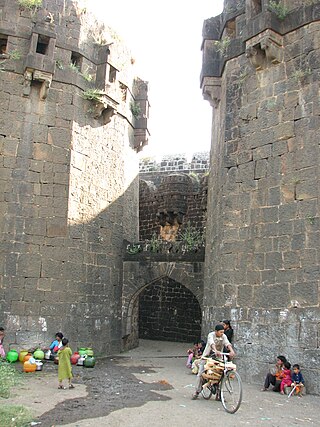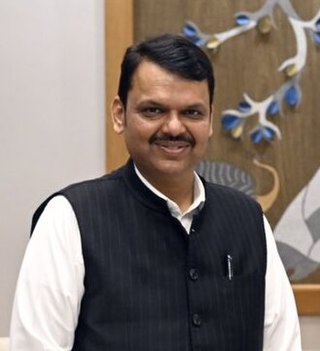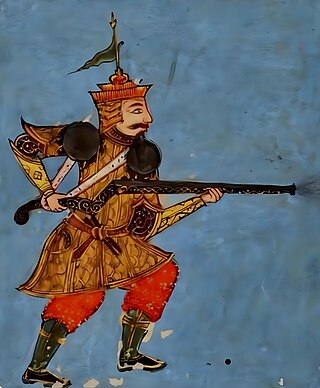
Osmanabad District, officially known as Dharashiv District, is an administrative district in the Marathwada region in the Indian state of Maharashtra. The district headquarter is located at Osmanabad. The District of Osmanabad derives its name from the last ruler of Hyderabad, the 7th Nizam, Mir Osman Ali Khan, of which the region was a part till 1947. This region was earlier part of The Hyderabad State until Independence.This primarily rural district occupies an area of 7,569 km2 (2,922 sq mi) of which 241.4 km2 (93.2 sq mi) is urban and has a population of 1,657,576 of which 16.96% were urban.
Ingoda is a village with a Gram panchayat in the Paranda Tehsil of Osmanabad district, Maharashtra state in India.
Deshpande is a surname native to the Indian states of Karnataka, and Maharashtra. The surname can be also found in some parts of Himachal Pradesh. Deshpande surname is found among the Deshastha Brahmins, Gaud Saraswat Brahmins (GSB) and the Chandraseniya Kayastha Prabhus (CKP).

Osmanabad, officially known as Dharashiv, is a city and a municipal council in Osmanabad district in the Indian state of Maharashtra. The city is the administrative headquarter of Osmanabad district. It is the seventh largest city in Marathwada, and the 39th largest city in Maharashtra by population.

Sindhudurg Fort is a historical sea fort located in Arabian Sea near the Konkan region of Maharashtra in Western India. The fort, commissioned by Chhatrapati Shivaji, was constructed between 1664 and 1667. The fort lies off the shore of Malvan taluka of the Sindhudurg District in the Konkan region of Maharashtra, 450 kilometres (280 mi) south of Mumbai. It is a protected monument under the Archaeological Survey of India.
Paranda is a town with a municipal council in the Osmanabad district of the Indian state of Maharashtra. It is the headquarters town for the Paranda Tehsil.

The Sultanate of Ahmednagar was a late medieval Indian Muslim kingdom located in the northwestern Deccan, between the sultanates of Gujarat and Bijapur, ruled by the Nizam Shahi dynasty. It was established when Malik Ahmed, the Bahmani governor of Junnar, after defeating the Bahmani army led by general Jahangir Khan on 28 May 1490, declared independence and established the Ahmadnagar Sultanate.

Khanderi is an island with a fort, located south of Mumbai, along the coast of Maharashtra, India.

Paranda Assembly constituency is one of the 288 Vidhan Sabha constituencies of Maharashtra state in western India.

Umarga Assembly constituency is one of the 288 Vidhan Sabha constituencies of Maharashtra state in western India.

Tuljapur Assembly constituency is one of the Maharashtra Vidhan Sabha constituencies, in Maharashtra state in western India.

Dharashiv Assembly constituency is one of the 288 Vidhan Sabha constituencies of Maharashtra state in western India.
Paranda Tahsil is a tahsil (subdistrict) in Osmanabad district, Marathwada region in Maharashtra on Deccan Plateau of India. The town of Paranda is the administrative headquarters of the tahsil. There are seventy-two panchayat villages in Paranda Tahsil.

Paranda Fort is situated in Paranda, a small town in the Osmanabad district in the state of Maharashtra, India. It is protected monument by the Archaeological Survey Of India. The fort may have been constructed in the 15th century by Mahmud Gawan or by Murtaza Nizam Shah II in the early 1600s. Paranda has great historical value and finde mention in Honnati inscription of Baka 1045 and also later a few of the Kalyan Chalukyan an copper plates. As well as in Yadava epigraphs, as Pallyanda Pratyandaka. The fort is attraction in this Paranda town and is known to have been built by Mahmud Gavan, the Prime Ministar of Muhammad Shah Bahmani 2.

Naldurg Fort is a historic fort in Naldurg town of Dharashiv district in Maharashtra state of India. Naldurg Fort is named after Nalraja who built the fort in medieval architectural style. The unique feature of the fort is that it encloses a knoll of basalt rock which juts out into the valley of the small Bori River and a long fortification wall with many bastions. The Naldurg fort is one of the important ground forts in the Marathwada region.

Dnyaneshwar Raosaheb Patil was a Shiv Sena politician from Osmanabad district. He was Member of the Legislative Assembly from Paranda of Osmanabad District, Maharashtra, India as a member of Shiv Sena. He has been elected consecutively for 2 terms in the Maharashtra Legislative Assembly for 1995 and 1999.
Tanaji Sawant is a businessman, Shiv Sena politician and deputy leader from Solapur district, Maharashtra. He is current Member of Legislative Assembly from Bhoom / Paranda / Washi Vidhan Sabha constituency as a member of Shiv Sena. He was elected to legislative council with a record margin of 270 votes, securing 348 votes.

A General assembly election is scheduled to be held in Maharashtra on 20 November 2024 to elect the 288 members of the 15th Maharashtra Legislative Assembly, the counting and the results will be declared on 23 November 2024.

The Bahmani Sultanate was the first Indian polity to use gunpowder weapons. Their firearms were the most advanced of their time, surpassing even those of the Yuan dynasty, the Mamluks of Egypt, and even European kingdoms during the same era. The first recorded use of firearms in South Asia occurred at the Battle of Adoni in 1368. In the Deccan, the Bahmani Sultanate, led by Mohammed Shah I, employed a train of artillery against the Vijayanagara Empire under Harihara II. Due to the efficient artillery of the Bahmani Sultanate, they achieved exemplary victory against the Vijayanagara Empire, which was still using outdated weapons. Gunpowder weaponry, including muskets, hand cannons, cannons, and war mortars, were employed by the Bahmani Sultanate in South India during the 14th to the 15th centuries.













